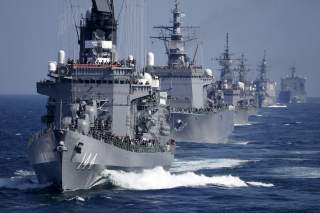These 5 Navies Are Uncontested On The High Seas
The world's top fleets.
This list catches the Royal Navy at a historic ebb in firepower. Like much of the British Armed Forces, the Royal Navy has seen successive waves of equipment and personnel cuts. The recent retirement of two Invincible-class aircraft carriers and the Sea Harriers of the Fleet Air Arm have greatly reduced the Royal Navy’s abilities. Nuclear firepower, as well as future aircraft-carrier plans earn it fourth place on the list.
The Royal Navy is the smallest on this list, with only 33,400 personnel on active duty and 2,600 in the reserves. The Royal Navy currently fields three large amphibious assault ships, 19 frigates and destroyers, seven nuclear attack submarines, and four nuclear-powered ballistic-missile submarines. The Royal Navy’s aviation force, the Fleet Air Arm, fields 149 aircraft, primarily helicopters.
The core of the Royal Navy’s surface force is its six Type 45 guided missile destroyers. Each destroyer of the Daring class is equipped with an advanced SAMPSON air tracking radar, similar to the SPY-1D radar of the U.S. Navy’s radar Aegis system. Paired with up to 48 Aster surface-to-air missiles, the destroyers can handle a wide spectrum of aerial threats, including ballistic missiles.
The Royal Navy’s submarine force has dwindled to less than a dozen submarines. The force of seven nuclear attack submarines is being upgraded by the introduction of the HMS Astute class. Astute and her sister ships carry Spearfish torpedoes and Tomahawk land attack missiles, and are among the most advanced submarines in the world. Four Vanguard-class ballistic-missile submarines constitute the U.K.’s nuclear deterrent. Each Vanguard weighs up to 15,900 tons submerged and is equipped with 16 Trident D II long-range ballistic missiles.
The Royal Navy will soon receive a quantum leap in capability with the construction of two new aircraft carriers, HMS Queen Elizabeth and HMS Prince of Wales. The two carriers, each weighing up to 70,000 tons fully loaded, will be the largest ships ever to sail in the Royal Navy. The carriers will each be capable of embarking up to 36 F-35B fighter-bombers and a number of helicopters.
Japan
The fifth navy on this list is unusual, because technically, it is not really a navy. Japan’s Maritime Self Defense Force (MSDF) is not a military force; its personnel are civil servants, not sailors. Largely under the radar, Japan has built up one of the largest, most-advanced and professionally manned naval forces in the world.
The MSDF has a total of 114 ships and 45,800 personnel. The core of the force is its large fleet of destroyers, designed to keep the sea-lanes to and from Japan from being cut as they were in the Second World War. This fleet of 46 destroyers—more than the British and French navies combined—has been expanded in recent years to accommodate new missions. Since the mid-2000s, the MSDF’s force of Aegis destroyers has been tasked with providing a defense umbrella against North Korean ballistic missiles.
Even more recently, Japan has constructed three so-called “helicopter destroyers”, each twice as large as the average destroyer with a strong external (and internal) resemblance to aircraft carriers. Indeed, these helicopter destroyers are carriers in all but name, designed to embark helicopters and—possibly in the future—F-35B fighter-bombers.
Japan has a modest, but growing amphibious capability. It has three tank landing ships of 9,000 tons that can move 300 troops and a dozen vehicles off-ship via helicopter and hovercraft. The helicopter destroyers can embark up to a battalion’s worth of marines from the new marine brigade to be based at Nagasaki, transport helicopters to carry them, and transport Apache attack helicopters to give them air support.
Japan’s submarine force is—ship-for-ship—one of the best in the world. There are 16 submarines in the JMSDF, the latest of the Soryu-class. Featuring an advanced air independent propulsion system, the Soryu submarines can remain submerged longer than other conventional submarines. The Japanese submarine fleet is young, with submarines retired at the average age of eighteen to twenty years. Japan has recently announced that the fleet would be increased to 22 submarines in response to the growing might of the PLAN.
Kyle Mizokami is a writer based in San Francisco who has appeared in The Diplomat, Foreign Policy, War is Boring and The Daily Beast. In 2009 he cofounded the defense and security blog Japan Security Watch. You can follow him on Twitter: @KyleMizokami. This article first appeared several years ago.
Image: Reuters.

